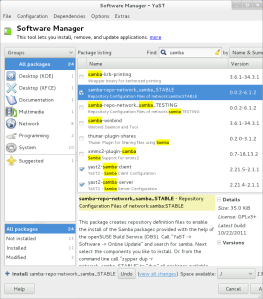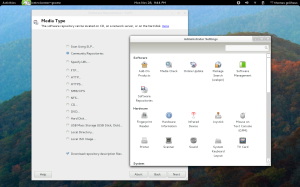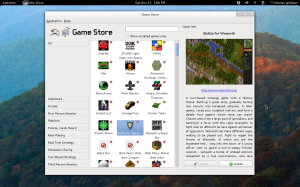The last time I used openSUSE was about 2 years ago (edition 11.2) and I wasn’t impressed enough to keep using it. But J.A. Watson of ZDNet.co.uk told me this new edition is much improved, so I decided to check it out. This review is for the 32-bit live CD edition (GNOME 3), but the website provides a KDE-focused version or a full DVD download, as well as a network installation version.
Installation
OpenSUSE uses YaST as its installation tool. It starts off by asking for preferred language, keyboard layout, and having you confirm the License Agreement. Then it asks you to confirm your timezone. Partitioning is next, and openSUSE shows a set of defaults that look pretty good – the space for the root partition seems a good size. Having a separate “/home” is checked by default, but you can uncheck if you want. If you don’t like the defaults, you can create, edit, or import your own setup. OpenSUSE 12.1 defaults to using the ext4 filesystem. The next step is to set a user and password. You can check the box for Administrator, receiving mail, and autologin. OpenSUSE doesn’t offer an indicator of password strength (having seen this idea in 2 or 3 others, it seems too useful to leave out). Finally, before actually installing the system, all your settings are shown so you can approve them (or make changes).
Features
openSUSE uses a slightly modified GNOME 3.2 – it adds minimize and reset buttons to the windows, and changes the “suspend” choice to suspend/hibernate/power off. You get only 3 wallpapers to start but you can easily install extra ones from the repositories. You can also add any of the newly written extensions for GNOME, which are found by searching for “gnome shell extension”. The additional window themes in the GNOME Tweak Tool are only half as many as for Fedora (but the tool shows up in the menu, unlike Fedora). It comes with 11 good games installed by default, which I always like. After installing extra codecs for media, you can easily view videos, listen to mp3s, or watch Quicktime movie trailers. Installing them wasn’t as easy as it is in Fedora, because there’s no one-step program for openSUSE similar to Autoplus or Fedora Utils. OpenSUSE uses RPM files for package management, but they are not always compatible between OpenSUSE, Fedora, and Mageia.
Unfortunately, openSUSE didn’t detect my wireless printer – an HP Photosmart Premium. Most distros that I have tried have had no problem seeing it.
Also, some of the buttons don’t get resized appropriately when notifications windows come up, leading to the need to “stretch” windows across the screen to reveal them.
I’ve never seen this behavior in Fedora.
Software
OpenSUSE is a little like Fedora, in that the first thing you want to do after installing it is grab extra repositories. Especially if (like me) you love playing games. Here is my list of repositories:
You do that by adding Community Repositories using the “Software Repositories” option in the YaST application:
Here is the install/remove software tool, showing one feature I like that is missing in Fedora: you see how many packages are in each section. It’s possible that Fedora just doesn’t have that option enabled.
As far as other software, openSUSE’s repositories do include most everything that I often want to try – graphics programs like Inkscape, Dia and Blender, programming tools like Python’s IDLE, Glade, and KDevelop, audio creation programs like Hydrogen, Audacity, Fillmore, and the JACK interface, and languages that include Ruby, Go, Lua and OCaml.
I need to mention that when I tried to use Brasero, GNOME’s CD burning program (which was included among the installed programs), I was told that I needed to install additional files. Yet even after installing those additional files, I still needed “cdrecord”, which I couldn’t find anywhere in the repositories I had enabled. I’m assuming that in the changeover from 11.4 to 12.1, that application didn’t get included for some reason. But this is the first time that Brasero has been installed by default in a distro, and still failed to run due to missing dependencies.
Games
After you add extra repositories (no, seriously, you don’t want to look at the games before you do that), openSUSE has a pretty decent set of games. I found most of the strategy, puzzle, FPS, and platforming games that I enjoy. The list seems to be on par with Fedora, perhaps a little better….except in one important area: emulators. There are barely any emulators for openSUSE 12.1. When I checked the forums, it sounds like earlier editions had some of what I usually like, but I guess they haven’t been built for the new edition yet.
OpenSUSE has a unique application: a Game Store – it seems to be a central place to install, uninstall, or launch games that are in the repositories. You will need to install it from the repositories beforehand, though (search for “gamestore”). I wish Fedora did this !
Help and support
There is a great deal of help from OpenSUSE official sources: The forums are here, the wiki is here, and the main page for OpenSUSE is here. The forums do seem to be quite active. After installation, the Firefox browser is already populated with all the official websites, under the “Bookmarks toolbar”.
KDE, Xfce, LXDE
OpenSUSE also supports the desktops KDE, Xfce and LXDE, and also the window managers IceWM, Openbox and Windowmaker. Grabbing all the necessary files from the repositories is less obvious than for Fedora or Mint – it wasn’t until I realized that openSUSE refers to meta packs as “patterns” that I felt confident trying to install LXDE and Xfce. But once I did so, they functioned just fine.
Final note
OpenSUSE 12.1 strikes me as an above average Linux distribution, and its popularity is a testament to that. I’m hard pressed to decide whether it is overall a better Linux distribution than Fedora. Each has very similar features, but includes a few programs and games that the other leaves out. They both use RPM packages, but I don’t think that you can always count on compatibility between the two distributions.





i have been install openSUSE 12.1 on my laptop between fedora 16 and ubuntu.. i think openSuse good too and have gnome-shell extentions (shutdown extentions) and that really helpful
By: jo13 (ashwin dexter winongo) on December 1, 2011
at 11:49 PM
Does openSUSE 12.1 support Playonlinux?
By: Romy on December 3, 2011
at 8:08 PM
Yes, it seems to:
http://pmbs.links2linux.org/package/show?package=playonlinux&project=Games
You’ll find it in the Packman group of extra repositories.
Also, Playonlinux is written in Python, so you can install the latest version directly from the site.
By: duskfire on December 4, 2011
at 8:31 AM
A fair and honest review. I would point out that Suse is very ties into KDE and is probably strongest there. Minor point of course but while you mentioned adding repositories you didn’t point out that you can add the ‘Tumbleweed’ repository to make it a rolling release OS. Something very few OSs can do at this point, but I think it will be a popular feature in the near future. Then, what do I know. Overall though a good review, thanks. Nice catch on the font/sizing or framing issue.
By: kensolar on December 21, 2011
at 1:47 AM
tied…not ties…oops, proofread.
By: kensolar on December 21, 2011
at 1:50 AM
🙂
By: Daticc77 on December 25, 2011
at 10:02 AM